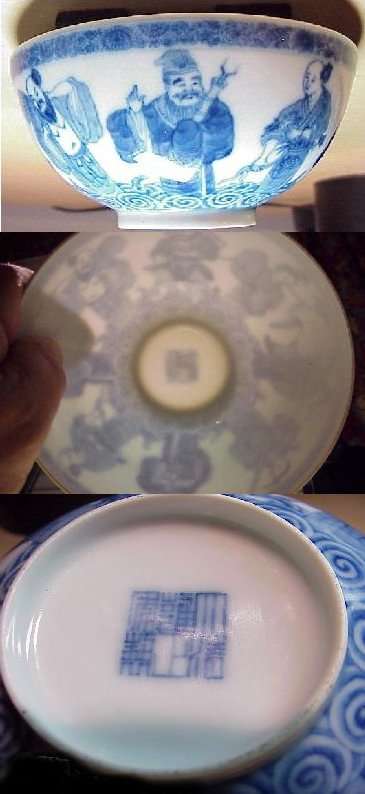
This page is only one of many thousands of Gotheborg.com Help and Information Pages, offering specialized knowledge on Chinese and Japanese Porcelain, including a Glossary, Q&A, Chinese and Japanese Porcelain Marks, Chinese Porcelain Exhibition and Excavation reports etc. For personal help and far more information, join our Discussion Board or use 'Ask a Question' for quick email consultations. For full text and better navigation, use a full-screen device rather than a mobile phone, that offers only limited content.
 I own a Chinese bowl that is almost translucent, it is decorated with 8
figures, it is 13.8cm in diameter and stand 6.5cm high, it has the Imperial
mark of Yongzheng and is very well done and finely decorated, it also appear
that it has the remnants of gold around the rim. The blue color and seal is under the glaze.
I own a Chinese bowl that is almost translucent, it is decorated with 8
figures, it is 13.8cm in diameter and stand 6.5cm high, it has the Imperial
mark of Yongzheng and is very well done and finely decorated, it also appear
that it has the remnants of gold around the rim. The blue color and seal is under the glaze.
I would appreciate to know what you can tell me about this piece.
Thank you for sharing your interesting piece with me.
First of all I must say that this bowl is a really good piece, especially if it like you say have underglaze blue decoration. I have thought a lot about several possibilities about a date but come to the conclusion that - based on what I can see of the pictures - it is rather modern. The oldest I can think of is the 1920s but the golden rim makes it possibly with a mid 50s date. They are still made like this today and I can't rule out anything regarding the date. All modern pieces must be judged on their own quality, which in this case is very good.
The decoration is of the eight "Lohans". They were pupils of Buddha who by wisdom had gained immortality but chosen to stay on earth to help the human beings.
I hope you are not too surprised by my opinion on the date, despite the Yongzheng mark. Eggshell thin pieces were actually made during the Yongzhen period. There were tea cups and saucers, and plates often with a "ruby back", but their bodies of the same thickness were less translucent.
Porcelain of eggshell thinness - so called bodiless ware - is heard of as early as from the Yonglo period of the Ming dynasty. Eggshell thin Qingbai pieces were also made during the Song dynasty. I have seen a couple of these, and they are unbelievable thin, like paper.
The production of modern eggshell porcelain started around 1916 during the period of Hongxian (1915-1916). In the planning of his official ware they settled for looking at the Yongzheng period as a model for the decoration after first having considered the Song dynasty. This is the most important reason for the revival of Famille rose enamel painting on porcelain at this time and a reason why the Yongzheng mark also speaks for the 1920s.
During the 1920-30 eggshell ware became an important part of the total production program in Jingdezhen with well over 3300 men occupied by 1928. A serious break in production took place when the Japanese took Jingdezhen in 1937 after a surprise attack on Shanghai in 1932, the most important export harbor city.
Eggshell thin porcelain is still made up to this day but most of it is decorated with enamels. Most of the less expensive pieces have their borders added with transfer prints and only the main decoration is hand painted.
If your bowl is an early eggshell from the 1920s I can only congratulate, since these are very rare. Even if it's a later piece - even if it was made yesterday - it is still good since the decoration is underglaze blue. We can only imagine what kind of efforts it takes to decorate an unfired piece of porcelain of this thinness.
The fragility and the tensions in the body of these piece have taken a great toll on what is still in existence today of the early pieces. So, go easy on your maid - these are really fragile pieces that might break in the heat of a spotlight in your own cabinet.
Jan-Erik Nilsson